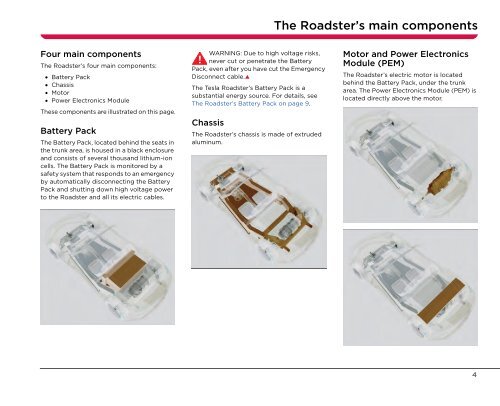Emergency Responder Guide Tesla Roadster
Create successful ePaper yourself
Turn your PDF publications into a flip-book with our unique Google optimized e-Paper software.
The <strong>Roadster</strong>’s main components<br />
The <strong>Roadster</strong>’s main components<br />
Four main components<br />
The <strong>Roadster</strong>’s four main components:<br />
• Battery Pack<br />
• Chassis<br />
• Motor<br />
• Power Electronics Module<br />
These components are illustrated on this page.<br />
Battery Pack<br />
The Battery Pack, located behind the seats in<br />
the trunk area, is housed in a black enclosure<br />
and consists of several thousand lithium-ion<br />
cells. The Battery Pack is monitored by a<br />
safety system that responds to an emergency<br />
by automatically disconnecting the Battery<br />
Pack and shutting down high voltage power<br />
to the <strong>Roadster</strong> and all its electric cables.<br />
WARNING: Due to high voltage risks,<br />
never cut or penetrate the Battery<br />
Pack, even after you have cut the <strong>Emergency</strong><br />
Disconnect cable.<br />
The <strong>Tesla</strong> <strong>Roadster</strong>’s Battery Pack is a<br />
substantial energy source. For details, see<br />
The <strong>Roadster</strong>’s Battery Pack on page 9.<br />
Chassis<br />
The <strong>Roadster</strong>’s chassis is made of extruded<br />
aluminum.<br />
Motor and Power Electronics<br />
Module (PEM)<br />
The <strong>Roadster</strong>’s electric motor is located<br />
behind the Battery Pack, under the trunk<br />
area. The Power Electronics Module (PEM) is<br />
located directly above the motor.<br />
4







